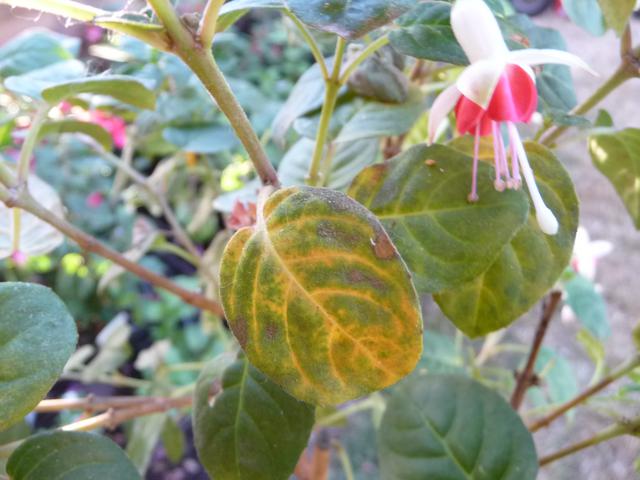Fuchsia Problem Solving
Strong-growing plants are less susceptible to diseases, pests, and weather conditions. Use open potting soil, keep plants positioned to avoid shock in sudden cold or hot weather, keep plants separated for air circulation, don’t overwater, and fertilize weekly with full strength balanced fertilizer. Don’t substitute the fertilizing for regular watering, and ensure the soil is damp before fertilizing. Most of the following pest problems can be eliminated by misting fuchsias daily in hot weather.
Watch your plants for problems such as:
YELLOWING LEAVES Progressive yellowing of the leaves means plants need fertilizing.
LEAF DROP Something has shocked the plant into dropping leaves to survive. It could be inadequate light, drying out, or overwatering. Leaf drop is especially common in hot weather.
Something has shocked the plant into dropping leaves to survive. It could be inadequate light, drying out, or overwatering. Leaf drop is especially common in hot weather.
SCORCH MARKS Marks on leaf tops or tips may be caused by salt damage, chemicals/fertilizers being used incorrectly or in extremely hot weather. Do not over-feed. Try to mitigate extreme heat by placing plants in as cool a place as possible and keeping air hydrated. Mist plants in mornings to compensate for heat. Keep plants out of extended sun exposure.
DUSTY RED LEAVES Red spider mites are especially active in hot, dry weather. Isolate affected plants & spray top AND BOTTOM of leaves with a miticide spray. Repeat spraying. Misting plants with plain water will help the plants fight this infestation. If severe, prune and destroy prunings.
SMALL WHITE BUGS are Whitefly! Treat with one of the commercial sprays suitable for fuchsias such as Orthene. Spray regularly, as only adults are killed. Spray over & under leaves, and avoid spraying blossoms. Repeat spraying often, usually every three days. Mist plants with water daily, and keep plants spaced well for good air circulation.
GREY MOLD is most common in cold, wet weather. Control watering, improve air circulation around plants, and remove all dead or damaged leaves.
RUSTY RED LESIONS Appearance of red circular lesions on older leaves is a symptom of fungus or rust. The rust spores disperse, and a dead, circular patch is left behind. Rust is prevalent in warm, humid weather (greenhouse anyone?). Remove all damaged leaves and destroy. You want to catch this early rather than late, or you could end up with a leafless plant as you combat the rust. Spray with commercial product to the undersides of leaves.
LEAF REDNESS Usually shows up when plants are exposed to low temperatures, especially after a rapid temperature drop. This usually causes little problem, except in the plant’s appearance.
FLOWER DROP means the plant has had a shock. Often this is caused by inadequate light, or a plant drying out rapidly in dry weather/wind. Fuchsias need to be kept damp. Morning watering & misting help prevent dry out, especially in chronically windy micro-climates. Ensure you do the best you can to protect your plants from excessive heat.
GNARLED LEAVES This is a result of aphids & common in greenhouse plants in the spring. Mist daily & keep good air circulation around plants. Spray with a suitable commercial product.
Aphids, spider mites and white fly are all attracted to yellow sticky cards. Use these among your fuchsias to avoid problems with these pests.
The Oregon Fuchsia Society
